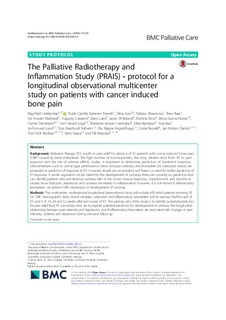| dc.contributor.author | Habberstad, Ragnhild H | |
| dc.contributor.author | Frøseth, Trude Camilla Salvesen | |
| dc.contributor.author | Aass, Nina Kathrine | |
| dc.contributor.author | Abramova, Tatiana Mikhailovna | |
| dc.contributor.author | Baas, Theo | |
| dc.contributor.author | Mørkeset, Siri Tessem | |
| dc.contributor.author | Caraceni, Augusto | |
| dc.contributor.author | Laird, Barry J | |
| dc.contributor.author | Boland, Jason W. | |
| dc.contributor.author | Rossi, Romina | |
| dc.contributor.author | Garcia-Alonso, Elena | |
| dc.contributor.author | Stensheim, Hanne | |
| dc.contributor.author | Loge, Jon Håvard | |
| dc.contributor.author | Hjermstad, Marianne Jensen | |
| dc.contributor.author | Bjerkeset, Ellen | |
| dc.contributor.author | Bye, Asta | |
| dc.contributor.author | Lund, Jo-Åsmund | |
| dc.contributor.author | Solheim, Tora Skeidsvoll | |
| dc.contributor.author | Vagnildhaug, Ola Magne | |
| dc.contributor.author | Brunelli, Cinzia | |
| dc.contributor.author | Damås, Jan Kristian | |
| dc.contributor.author | Mollnes, Tom Eirik | |
| dc.contributor.author | Kaasa, Stein | |
| dc.contributor.author | Klepstad, Pål | |
| dc.date.accessioned | 2018-11-23T12:33:45Z | |
| dc.date.available | 2018-11-23T12:33:45Z | |
| dc.date.created | 2018-10-23T13:17:50Z | |
| dc.date.issued | 2018 | |
| dc.identifier.citation | BMC Palliative Care. 2018, 17:110 1-11. | nb_NO |
| dc.identifier.issn | 1472-684X | |
| dc.identifier.uri | http://hdl.handle.net/11250/2574593 | |
| dc.description.abstract | Background
Radiation therapy (RT) results in pain relief for about 6 of 10 patients with cancer induced bone pain (CIBP) caused by bone metastases. The high number of non-responders, the long median time from RT to pain response and the risk of adverse effects, makes it important to determine predictors of treatment response. Clinical features such as cancer type, performance status and pain intensity, and biomarkers for osteoclast activity are proposed as predictors of response to RT. However, results are inconsistent and there is a need for better predictors of RT response. A similar argument can be stated for the development of cachexia; there are currently no predictors that can identify patients who will develop cachexia later in the cancer disease trajectory. Experimental and preclinical studies show that pain, depression and cachexia are related to inflammation. However, it is not known if inflammatory biomarkers can predict CIBP, depression or development of cachexia.
Methods
This multicenter, multinational longitudinal observational study will include 600 adult patients receiving RT for CIBP. Demographic data, clinical variables, osteoclast and inflammatory biomarkers will be assessed before start of RT, and 3, 8, 16, 24 and 52 weeks after last course of RT. The primary aim of the study is to identify potential predictors for pain relief from RT. Secondary aims are to explore potential predictors for development of cachexia, the longitudinal relationship between pain intensity and depression, and if inflammatory biomarkers are associated with changes in pain intensity, cachexia and depression during one-year follow up.
Discussion
The immediate clinical implication of the PRAIS study is to identify potential predictive factors for a RT response on CIBP, and thereby reduce non-efficacious RT. Patient benefits are fewer hospital visits, reduced risk of adverse effects and more individualized pain treatment. The long-term clinical implication of the PRAIS study is to improve the knowledge about inflammation in relation to CIBP, cachexia and depression and potentially identify associations and mechanisms that can be targeted for treatment. | nb_NO |
| dc.language.iso | eng | nb_NO |
| dc.publisher | BMC (part of Springer Nature) | nb_NO |
| dc.rights | Navngivelse 4.0 Internasjonal | * |
| dc.rights.uri | http://creativecommons.org/licenses/by/4.0/deed.no | * |
| dc.title | The Palliative Radiotherapy and Inflammation Study (PRAIS) - Protocol for a longitudinal observational multicenter study on patients with cancer induced bone pain 11 Medical and Health Sciences 1103 Clinical Sciences | nb_NO |
| dc.title.alternative | The Palliative Radiotherapy and Inflammation Study (PRAIS) - Protocol for a longitudinal observational multicenter study on patients with cancer induced bone pain 11 Medical and Health Sciences 1103 Clinical Sciences | nb_NO |
| dc.type | Journal article | nb_NO |
| dc.type | Peer reviewed | nb_NO |
| dc.description.version | publishedVersion | nb_NO |
| dc.source.pagenumber | 1-11 | nb_NO |
| dc.source.volume | 17:110 | nb_NO |
| dc.source.journal | BMC Palliative Care | nb_NO |
| dc.identifier.doi | 10.1186/s12904-018-0362-9 | |
| dc.identifier.cristin | 1622666 | |
| dc.description.localcode | © The Author(s). 2018 Open Access. This article is distributed under the terms of the Creative Commons Attribution 4.0 International License (http://creativecommons.org/licenses/by/4.0/) | nb_NO |
| cristin.unitcode | 194,65,15,0 | |
| cristin.unitcode | 194,65,25,0 | |
| cristin.unitname | Institutt for klinisk og molekylær medisin | |
| cristin.unitname | Institutt for sirkulasjon og bildediagnostikk | |
| cristin.ispublished | true | |
| cristin.fulltext | original | |
| cristin.qualitycode | 1 | |

